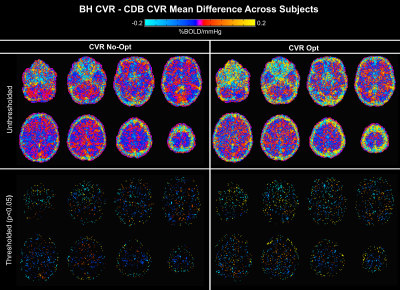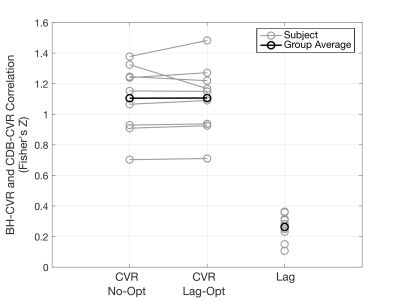Kristina M. Zvolanek1,2, Rachael C. Stickland2, Stefano Moia3,4, Apoorva Ayyagari1,2, César Caballero-Gaudes3, and Molly G. Bright1,2
1Biomedical Engineering, Northwestern University, Evanston, IL, United States, 2Physical Therapy and Human Movement Sciences, Northwestern University, Chicago, IL, United States, 3Basque Center on Cognition, Brain and Language, Donostia, [Gipuzkoa], Spain, 4University of the Basque Country EHU/UPV, Donostia, [Gipuzkoa], Spain
1Biomedical Engineering, Northwestern University, Evanston, IL, United States, 2Physical Therapy and Human Movement Sciences, Northwestern University, Chicago, IL, United States, 3Basque Center on Cognition, Brain and Language, Donostia, [Gipuzkoa], Spain, 4University of the Basque Country EHU/UPV, Donostia, [Gipuzkoa], Spain
Our results demonstrate comparable BOLD cerebrovascular reactivity (CVR) and hemodynamic lag measurements between breath-hold and deep breathing tasks, suggesting that the two tasks can be used interchangeably in healthy participants.

Voxelwise maps of the Bland-Altman analysis showing mean difference between breath-hold (BH) and cued deep breathing (CDB) cerebrovascular reactivity (CVR) across all subjects. Differences in non-optimized CVR (No-Opt) are shown on the left, lag-optimized on the right, with thresholded maps for each in the bottom row (p<0.05). Negative values represent voxels with greater BH CVR than CDB CVR, and vice versa. Significant differences appear primarily at brain edges and in white matter.

Voxelwise correlations between breath-hold (BH) and cued deep breathing (CDB) cerebrovascular reactivity (CVR) before lag optimization (No-Opt), lag-optimized CVR (Lag-Opt), and lag. A Fisher's Z transform was performed on individual subject correlations to calculate a group average. All single subject Fisher’s Z values are significantly different from 0 at an alpha-level of 0.05 (Z>0.0232).
